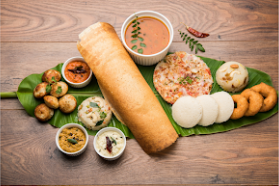South And Western Indian Cuisine

Southern Cuisine:
South Indians stand out with more priority on rice because it is the main grain, the universal availability of sambar (also known as chaaru, vegetable stew based on tamarind and toovar dal), and rasam (also known as rasa. , a soup made from tamarind or tomato juice, peppers, and various spices), lots of cucumbers, and the free consumption of coconut and especially coconut oil and curry leaves.
Dosa, pouri, idli, vada, bonda and bajj are often South Indian favorites and are often eaten as breakfast. Hyderabadi biryani, a popular type of biryani, showcases a variety of southern Indian delicacies.
Andhra, Chettinad, Tamil, Hyderabadi, Mangalorean, and Kerala cuisines all have amazing flavors and recipes. Each region of South India has its own unique way of making the right sambar; South Indian delicacies can bring without a doubt the difference between sambar from Kerala, sambar from Tamil delicacies, Sambar from Karnataka, and Pappu Charu from the Andhra temples. Other popular dishes include biryani, ghee, rice curry rice, seafood (prawns, mussels, mackerel), and pathiris with parchment paper from the Malabar area.
Tamil delicacies usually divide food into six popular foods: candy (milk, butter, sweet cream, wheat, ghee (specified butter), rice, honey); sour (lime and lemon, citrus fruits, yogurt, mango, tamarind); salt (salt or cucumber); sour (sour cream, many vegetables, turmeric, fenugreek); spicy (pepper, ginger, black pepper, clove, mustard) and astringent (beans, lentils, turmeric, vegetables such as cauliflower and cabbage, cilantro).
Traditional Tamil delicacies recommend that each of these six flavors be preserved in all major foods to provide overall nutrition, limiting appetite and stability of appetite and digestion. Common foods served with banana leaf, include sugary rice mixed with a host of vegetarian dishes such as sambar, dried curry, rasam, and kootu. Food is often seen with clean appalams.
After the last round of rice and sugar or buttermilk or whatever, the meal ends with a little banana and betel leaves and nuts.
Western Cuisine:
Western India has three basic food groups: Gujarati, Maharashtrian, and Goan. There are several types of Maharashtrian delicacies, described in terms of local conditions. Coastal areas, such as Goa, consume large quantities of rice, coconuts, and fish. In the hilly areas of the Western Ghats and Deccan plateau, nuts are used in the coconut area and basically jawar (sorghum) and bajra (sorghum) as a base. The Saraswat delicacy is an integral part of the Konkani Indian coast delicacies.
Gujarati delicacies eat most vegetables. Many Gujarati dishes have a touch of sweetness due to the use of sugar or brown sugar. Typical Gujarati cuisine includes Rotli (flat bread made from wheat flour), dal or card, rice, and sabzi / shaak (a dish made from a variety of vegetables and spices, which can be fried, spiced, or sweet).
The basic ones include homemade cucumber, Khichdi (rice and lentil or rice and mung bean daal), and chhaas (buttermilk). The main dishes are based entirely on roasted vegetables and daals that may be introduced to vaghaar, which is a combination of spice infused in warm oils that vary depending on the main ingredient. Salt, sugar, lemon, lime, and tomatoes are often used to save dehydration in an area where the temperature reaches 50C (120F) in the shade.
Goa delicacies are inspired by their Hindu origins, Portuguese colonialism, and modern methods. The basic diet of Goans is rice and fish and the delicacies are usually seafood – basically based. Kingfish (Vison or Visvan) is a very interesting place, not unusual; others include pomfret, shark, tuna, and mackerel.
Popular shells include crabs, prawns, tiger prawns, lobsters, squid, and mussels. Goan Hindu delicacies are very spicy, use very little onion or garlic, and contain lots of vegetables, lentils, pumpkins, pumpkin, bamboo shoots, and roots.
Restaurant:
Indian cuisine in the restaurant is commonly known as thali and is served with a round tray made from both silver, stainless steel, or copper, with a choice of various dishes in small bowls.
Depending on the restaurant, specialty, vegetarian or non-vegetarian food; one may also find oneself in South Indian (vegetable) thali, Chettinad thali, Mumbai thali, Rajasthani thali, or Gujarati thali.
Rice, even in small quantities, is an important part of that. Northern India thali is specially made from Indian bread and chapati, roti, paratha, phulka, or naan in combination with rice, while South African thalis are commonly served with rice.
In Northern India delicacies, pookis and chappati are served first and the waiter serves rice later, usually in a separate bowl. The rest of the ingredients, as well as the special curries, sweets, and various other ingredients (applam, papad, cucumber, and beeda), are compared to each thalis in North India and South India.
Some restaurants offer ‘unlimited’ thalis, with “bottomless” filling in all thal ingredients, so that the customer can eat until they are completely satisfied. In a few places, a seasonal approach to the unlimited help of everything on the plate except for things like dessert or vada.
Finally, bananas, beeda, and a pot of juice or lassi may be offered.
Specific Content Keywords : South Indian cuisine,Tamil Nadu cuisine,Kerala cuisine,Andhra cuisine,Karnataka cuisine,South Indian dosa recipes,Idli and sambar recipes,Coconut chutney recipes,South Indian vegetarian dishes,South Indian seafood recipes,South Indian breakfast recipes,South Indian thali,South Indian sweets,South Indian spices.

